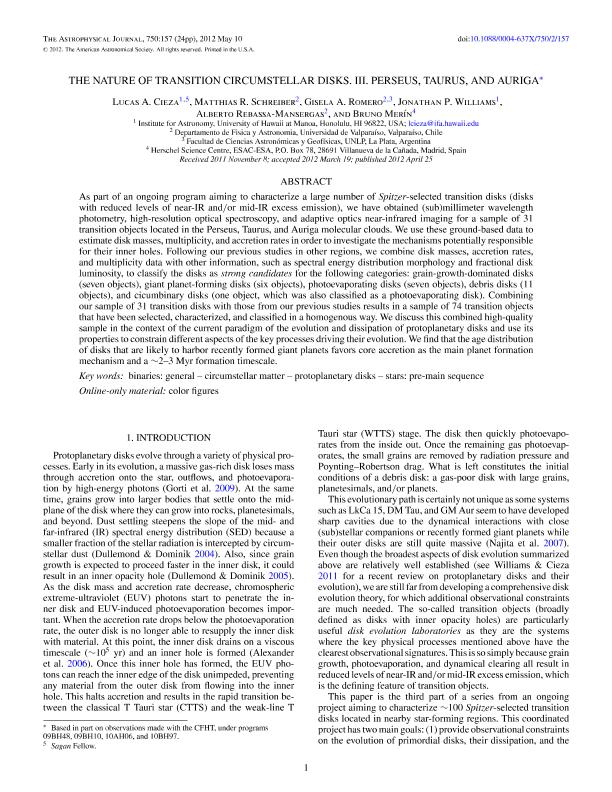Artículo
The nature of transition circumstellar disks. III. Perseus, Taurus, and Auriga
Cieza, Lucas A.; Schreiber, Matthias R.; Romero, Gisela Andrea ; Williams, Jonathan P.; Rebassa Mansergas, Alberto; Merín, Bruno
; Williams, Jonathan P.; Rebassa Mansergas, Alberto; Merín, Bruno
 ; Williams, Jonathan P.; Rebassa Mansergas, Alberto; Merín, Bruno
; Williams, Jonathan P.; Rebassa Mansergas, Alberto; Merín, Bruno
Fecha de publicación:
05/2012
Editorial:
IOP Publishing
Revista:
Astrophysical Journal
ISSN:
0004-637X
Idioma:
Inglés
Tipo de recurso:
Artículo publicado
Clasificación temática:
Resumen
As part of an ongoing program aiming to characterize a large number of Spitzer-selected transition disks (disks with reduced levels of near-IR and/or mid-IR excess emission), we have obtained (sub)millimeter wavelength photometry, high-resolution optical spectroscopy, and adaptive optics near-infrared imaging for a sample of 31 transition objects located in the Perseus, Taurus, and Auriga molecular clouds. We use these ground-based data to estimate disk masses, multiplicity, and accretion rates in order to investigate the mechanisms potentially responsible for their inner holes. Following our previous studies in other regions, we combine disk masses, accretion rates, and multiplicity data with other information, such as spectral energy distribution morphology and fractional disk luminosity, to classify the disks as strong candidates for the following categories: grain-growth-dominated disks (seven objects), giant planet-forming disks (six objects), photoevaporating disks (seven objects), debris disks (11 objects), and cicumbinary disks (one object, which was also classified as a photoevaporating disk). Combining our sample of 31 transition disks with those from our previous studies results in a sample of 74 transition objects that have been selected, characterized, and classified in a homogenous way. We discuss this combined high-quality sample in the context of the current paradigm of the evolution and dissipation of protoplanetary disks and use its properties to constrain different aspects of the key processes driving their evolution. We find that the age distribution of disks that are likely to harbor recently formed giant planets favors core accretion as the main planet formation mechanism and a 2-3Myr formation timescale.
Archivos asociados
Licencia
Identificadores
Colecciones
Articulos(CCT - LA PLATA)
Articulos de CTRO.CIENTIFICO TECNOL.CONICET - LA PLATA
Articulos de CTRO.CIENTIFICO TECNOL.CONICET - LA PLATA
Citación
Cieza, Lucas A.; Schreiber, Matthias R.; Romero, Gisela Andrea; Williams, Jonathan P.; Rebassa Mansergas, Alberto; et al.; The nature of transition circumstellar disks. III. Perseus, Taurus, and Auriga; IOP Publishing; Astrophysical Journal; 750; 2; 5-2012; 157-181
Compartir
Altmétricas



